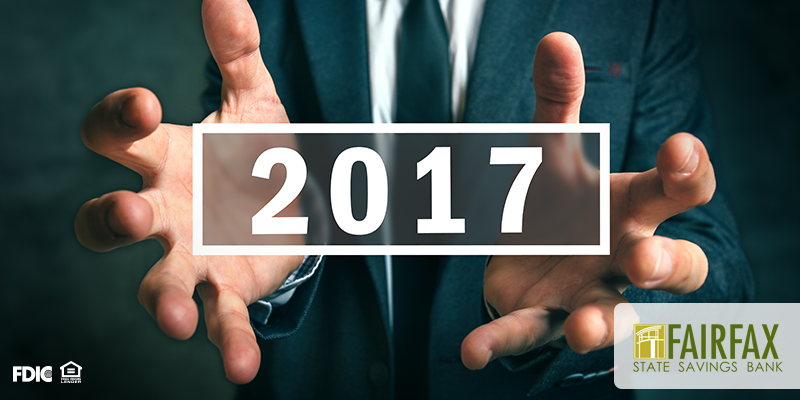7 Financial Goals to Make 2017 a Success
Posted on | Categories: Budgeting, Personal Finances, Retirement, Savings

Fairfax State Savings Bank challenges you to make 2017 the year of financial prosperity. Complete with an emergency fund, sound credit, and a monthly budget, you can conquer any fiscal goal so long as you keep moving towards it. To optimize your money management potential, we recommend these seven goals:
- Check Your Credit Score. There are many websites available which allow you to view your current credit score across the three reporting bureaus. However, the only federally authorized FREE site is annualcreditreport.com. This site gives users one free report from Equifax, TransUnion and Experian every year. By keeping regular track of your score, you can ensure that no fraudulent inquiries have been made, and no outstanding debts are currently being held against you. After all, a higher credit score could mean potential savings elsewhere.
- Make a Monthly Budget. This tool is invaluable when building your personal financial success. By creating a plan for each dollar you earn you are no longer reacting to your spending, but proactively telling your money where it should go. Adding this transparency to your spending can often showcase areas where you may be spending more than desired. After adjusting your monthly allocations you can then reassign some of those dollars to help build your personal savings and other areas of improvement.
- Automate Your Savings. “Out of sight, out of mind,” or so the saying goes. Adding processes to your budget, such as automated savings, can help you to accumulate money before you miss it. Before you start planning your spending for the month, determine how much you want to save. So long as your fixed monthly expenses are covered, you can then create an automatic monthly transfer from your checking to your savings. By doing this the same day you are paid, the funds will be gone before you even know to miss them. You can then budget the rest of your spending to cover flexible categories like groceries, entertainment, and more.
- Start an Emergency Fund. In order to safeguard your savings, you’ll need to create an emergency fund. This particular account offers protection against unexpected expenses or dilemmas that could otherwise infringe upon your diligent accrual of funds. It is often recommended to begin by saving $1,000, and then gradually work up to three or six months worth of income. By adding this cushion to your personal finances, you ensure that you are financially stable enough to weather storms both big and small.
- Submit Your Taxes Early. Tax fraud is an increasingly relevant issue, posing many problems for both the IRS and tax paying citizens. To help avoid potential criminals from using your information to their benefit, we suggest completing your tax return as soon as possible. Additionally, if you have a potential tax refund, the earlier you file your return, the sooner you are able to receive it.
- Maximize Your 401(k). To make the most of your diligent savings, we recommend revisiting your HR materials, to find out the specifics of your company’s 401(k) plan. If they will match up to ten percent, and you’re only contributing six, you could be missing out on free funds! Additionally, if you want to retire by a certain age, you may need to adjust your contributions to maximize the years you still have during your employment.
- Pay Down Your Credit Cards. Interest rates on credit cards are infamous for being consistently high. If you have multiple credit cards which carry a balance, we recommend paying down the account that has the least amount on it. By continuing to pay the minimum installment on each card, you can then assign any additional funds to the card with the lowest value, to help pay it off sooner. Once the first card is no longer carrying a balance, you can then utilize the monthly installment and the additional funds to put toward the next card and continue through the accounts.
